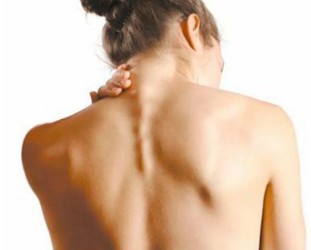Cervical osteochondrosis — a disease of the intervertebral discs in the cervical spine (usually C5, C6 and C7), which is degenerative in nature and which is characterized by proliferation of bone tissue in the cervical spine. Which are formed on the vertebrae osteophytes (calcification, spurs) irritate the muscles, causing their reflex to compression and increase pressure on the vertebrae. In the result, the intervertebral discs are compressed, their thickness is reduced, which also contributes to compression of the vertebral artery and the infringement of the nerve endings in the turning of the head.

In these reasons that cervical osteochondrosis phenomenon is a very dangerous disease. It disrupts the blood supply to the brain and provokes anoxia brain regions with possible complications.
The danger of cervical degenerative disc disease
Cervical osteochondrosis — serious isnae disease, symptoms of which are not limited to pain in the area of the cervical when moving the head. In the absence of treatment with the development of the disease the patient faces many complications, which cause significant discomfort and can cause various dysfunctions of the body.
Pressing the artery that arises from the fact that the vertebrae are deformed and approach leads to the so-called vertebral-basilar syndrome. Lack of blood flow and the brain becomes the cause of imbalance, dizziness, regular or permanent visual impairment, the occurrence of noise in the ears, faint and dizzy and lost consciousness. Depending on the ad by displacement of the artery of the cervical spine and General characteristics of the organism the consequences can manifest in varying degrees of severity and combined with each other.
Pinching of the occipital nerve in cervical degenerative disc disease becomes the cause of persistent headaches which are felt in the neck and in the head. The most dangerous phenomenon is the pinching of the spinal cord and its nerve branches. This may occur seriously etnia dysfunction, which consist of loss of coordination of limbs, decrease of sensitivity, loss of power. Also the patient may experience difficulties controlling your bladder and intestines, are often observed spastic uncontrolled movements of the legs.
Without treatment, osteochondrosis of the cervical causes of complications such as protrusion and hernia of the intervertebral discs of the cervical spine. It also contributes to the emergence and development of vascular diseases that cause various abnormalities of the brain the way but the death of its individual parts.
Causes of degenerative disc disease of the cervical spine
Although conventional medicine considers degenerative changes in intervertebral discs of the cervical disease, e with the point of view of osteopathy is only a manifestation of underlying disorders in the body.
Thus, the true causes of cervical osteochondrosis are as follows:
- Incorrect posture. Scoliosis, stoop, round back, kyphosis and other posture disorders, even if they are minor in nature, cause serious isnae imbalance of the spine. As a result, the load on the intervertebral discs is distributed unevenly, which causes their deformation and excessive wear. The vertebrae begin to move closer, causing pinching of the nervous processes, quickly developing cervical osteochondrosis. Similar effects have posture disorders, caused by a change in the natural position of the ribs.
- Muscle spasms. The spasmodic reaction of the back muscles, the chest press can lead to the fact that separate parts of a whole are too tight. As a result of impaired General equilibrium position a, causing a change in the position of the spine. Deformation may affect the cervical or other parts of the spine, causing degenerative disc disease of the thoracic, cervical, lumbar.
- A blood disorder. Because spinal discs have no direct connection with the bloodstream, the food they receive from the surrounding tissues. Circulatory disorders of the cervical results in Yes, the fact that the drives are not getting enough fluids for rehydration (recovery of the shape due to moisture absorption), the updates of cartilage. The result is accelerated deterioration, a decrease in the distance between the cervical vertebrae that causes the degenerative disc disease.
- The violation of innervation. Decreased sensitivity of nerve roots leads to pathological changes in their structure, causing displacement and deformation of the vertebrae of the cervical remains unnoticed by the patient. Because pain are lacking due to loss of sensitivity.
- Diseases of internal organs. Incorrect position of internal organs, movement and lowering due to various causes dysfunction and disruption of the overall equilibrium in the body. The result is particularly noticeable in the position of the spine — cervical, lumbar vertebrae is displaced and deformed, resulting and respective types of low back pain.
In General, the cervical osteochondrosis develops after exposure to adverse external factors that disrupt the natural equilibrium position of the spine and other systems of the human body. Often, these violations become noticeable not at once, and cervical degenerative disc disease progresses, leading to heavy consequences. It is therefore important to regularly visit an osteopath who will be able to fix the reasons that caused the degenerative disc disease of the cervical vertebra and not to treat the symptoms, as does traditional medicine.
Signs of cervical degenerative disc disease
According to the ad, which affects the cervical vertebrae low back pain, symptoms can manifest in various ways. But if you have at least one, should be suspected osteochondrosis of the cervical spine, so it makes sense the circulation and experts to conduct a comprehensive examination and diagnosis. The main symptoms of degenerative disc disease of the cervical spine:
- Pain. The first symptom of the phenomenon is pain, which in the early stages manifests itself only when turning and tilting his head. The discomfort is usually localized in the right or left area of the cervical, hours, the symptoms spread to the nearby region. With the development of cervical degenerative disc disease the pain radiates to the occipital and frontal part of head is migraine.
- The deterioration of the senses. Mostly begin to experience vision problems. Bright symptoms — blurred, double vision, darkening of the eyes, which is regular, is frequently observed noise in the ears.
- Dizziness. Almost always the cervical osteochondrosis accompanied by a characteristic attack, which occurs when sudden movement or head rotation, tilt, change poses. This can cause nausea and vomiting.
- Fainting. A semiconscious state and loss of consciousness are common symptom later stages of cervical degenerative disc disease. In some patients these symptoms may occur during initial development of the disease;
- Cardialgia. Along with other symptoms often there are sensations characteristic of angina attacks;
- Violations of sensitivity. According to the ad, which vertebrae are affected with cervical osteochondrosis, a sign of the presence of the disease is a partial loss of sensation in the occipital and parietal areas of the head, in the shoulder region, forearm. In some cases, the numbness may spread hell neck on the arm up so the little finger or thumb, respectively, the external or outer side of the limb;
- A speech disorder. The phenomenon is not very common symptom and occurs because of a loss of control over the tongue, owing to squeezing of the nerve roots C3 and C4. Also you experience difficulty breathing.
Usually the symptoms, which is characterized by osteochondrosis of the cervical, appear fairly bright — separately and in combination. So diagnosing them can even be yourself. At the first signs it is recommended to contact di specialist osteopath for which cervical degenerative disc disease, symptoms and treatment — one of the areas of professional activity.

Osteopathic treatment of degenerative disc disease of the cervical spine
To date osteopathic treatment of degenerative disc disease of the cervical phenomena is the most effective. It is aimed at addressing the root causes, not just dealing with the symptoms that manifest in the form of deformation and protrusion of intervertebral discs.
Faced with cervical osteochondrosis, specialist osteopath first diagnose the disease and its localization in the part of the neck, that is, determines which vertebrae is displaced and deformed. This can be done as guided by the symptoms of degenerative disc disease, and by manual examination of the patient.
The initial phase of treatment of cervical degenerative disc disease — the relief of pain. Often their cause is cervical spasm, treatment which is carried out by a specialist. The spasmodic reaction of the cervical muscles in response to the violation of the General balance in the body, and causes compression of the nerve roots. As a result, experiencing pain in the cervical area (osteochondrosis).
Often the elimination of spasms by itself, phenomena is quite an effective treatment of the cervical spine. Removing muscle tension, osteopath is not easy relieves pain, but also normalizes the position of the spine. Cervical with proper treatment comes in the equilibrium position and is unloaded.
After a few sessions of osteopathy signs of cervical degenerative disc disease are minimized or disappear altogether. This is due to the normalization of blood circulation, which often interfere with the muscle that is cramping. The cervical portion of the spine and intervertebral discs have normal food along with blood, and as a result the degenerative disc disease of the cervical vertebra retreats.
In the later stages of the disease, when violations are global in nature and often affect other organs, you may need more complex and long-term treatment. The specialist treats not only the degenerative disc disease of the spine, but also the associated disease and dysfunction, including the displacement of internal organs, oxygen starvation of a brain, infringement of processes of the spinal cord, etc.
Despite the severity of the disease, osteochondrosis of the cervical spine is quite well treated it osteopathic techniques. But to sustain progress and prevent complications and recurrence of the disease specialist is recommended additional methods — physical therapy, correction of nutrition, moderate exercise, massage and physiotherapy.
According to hell also the extent to which identified and may what causes low back pain, treatment is chosen individually by a specialist. According to Ada a result, the treatment can be adjusted and complemented with other procedures that helps to effectively and quickly cure the degenerative disc disease of Department.
Prevention of cervical degenerative disc disease
If you are diagnosed with "osteochondrosis of the cervical spine", the treatment can take a long hour. It is much easier to avoid this disease at all, leading a healthy lifestyle. To avoid long and complex treatment of degenerative disc disease (which is usually for the later stages) can be fairly simple methods of prevention.
Education of correct posture from an early age helps to avoid treatment of degenerative disc disease in adulthood. Very often this disease affects office workers, leading a sedentary lifestyle and spend a long time in the same position. To avoid osteochondrosis of the vertebrae, it is necessary to do regular exercise, change the position a, to perform the bending and twisting of the head, moderately loading of the shoulder girdle.
Sports activities aimed at the General strengthening of the muscles, joints and bones significantly reduce the risk of osteochondrosis of the lumbar or cervical.
And Even if you already have a degenerative disc disease (the symptoms are quite bright), and preventive exercises will help to mitigate the disease. But it should be remembered that by themselves they do not phenomena are treated. You must undergo a course by a specialist osteopath. The next prevention will be the guarantee that signs of degenerative disc disease will not manifest itself the disease does not return.




























